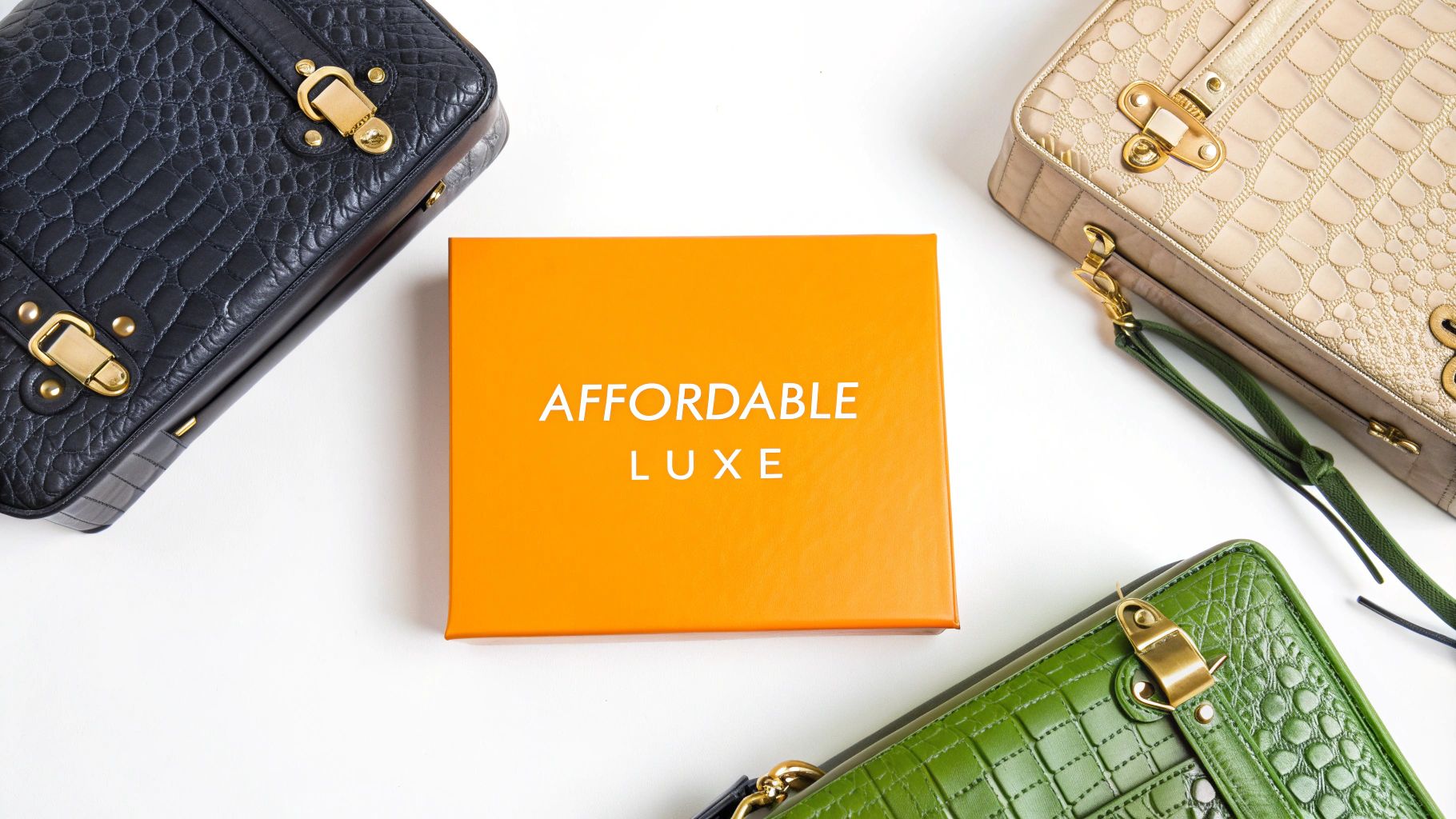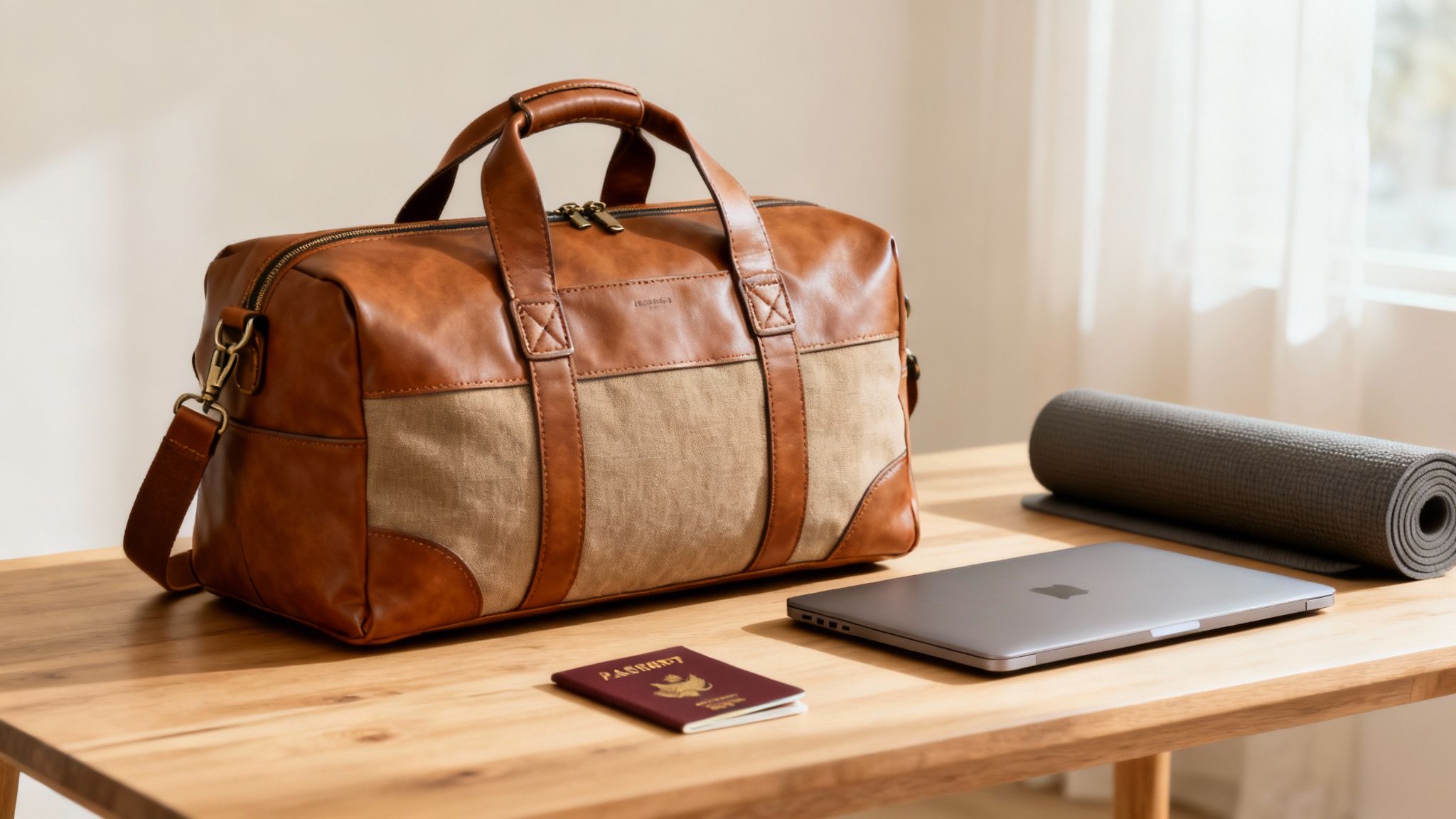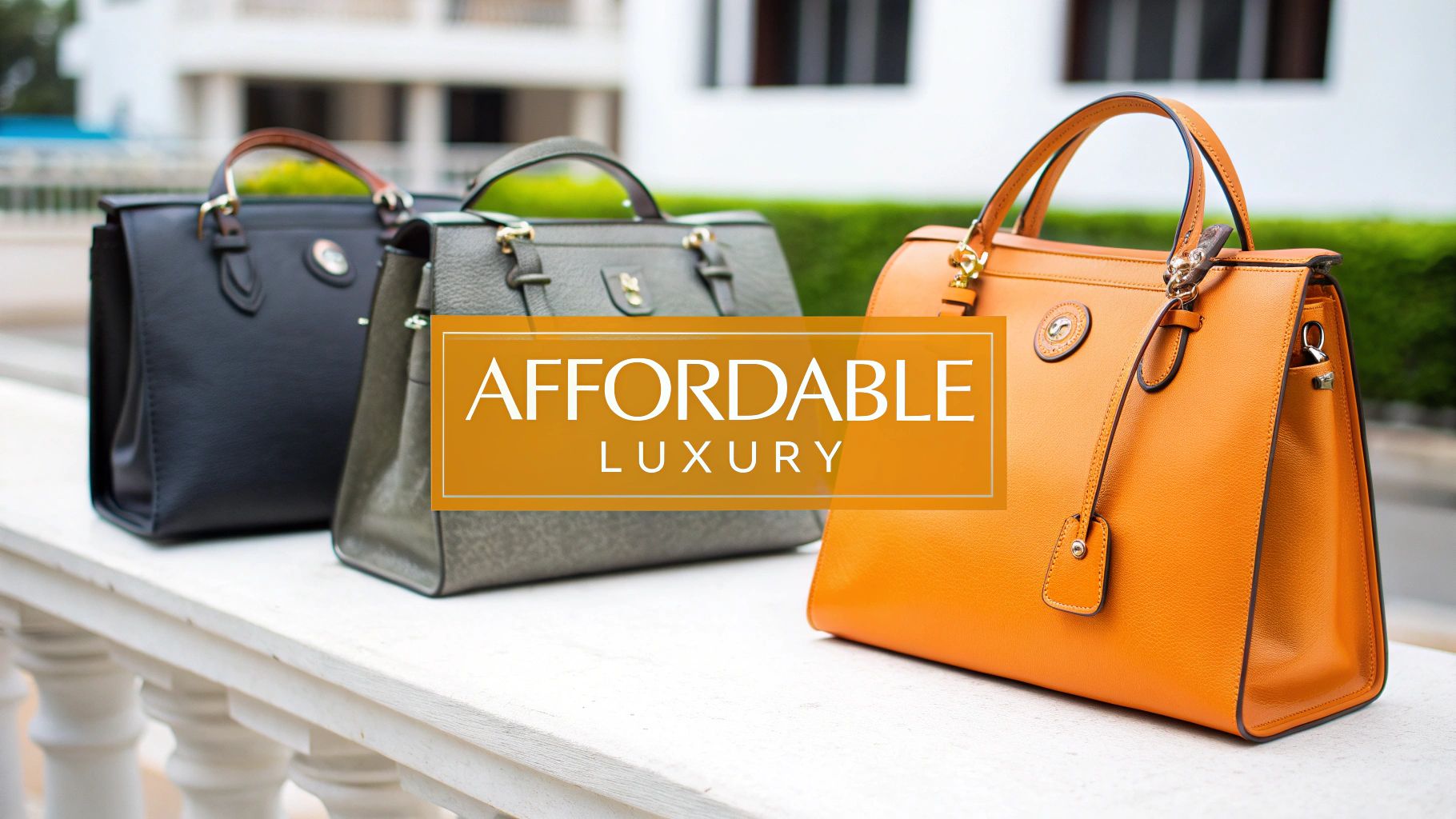Finding the Best Leather Handbags Women Will Love
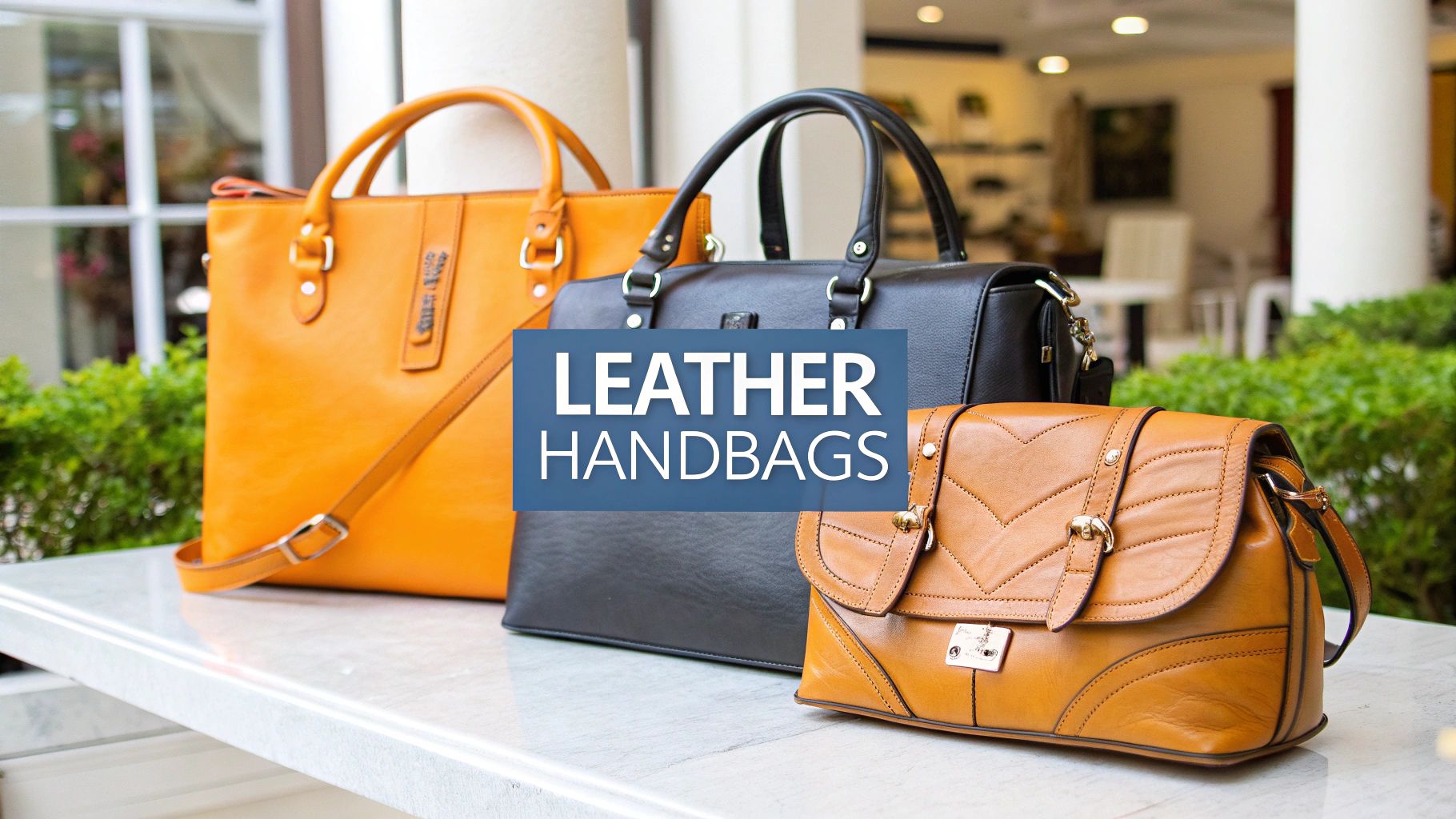
When you're looking for one of the best leather handbags women can own, it all comes down to a few key things: incredible craftsmanship, materials that are built to last (like real full-grain leather), and a style that just doesn't quit. A great leather bag is so much more than an accessory. It's a partner you take with you every day, one that actually gets better and more beautiful with age. That's an investment worth making.
Why a Leather Handbag Is a Timeless Investment
A high-quality leather handbag isn't just a fleeting trend—it's a statement of personal style and practicality that truly lasts. Unlike synthetic materials that often show wear and tear after just a season, leather has a natural strength that stands up to daily life while developing a gorgeous, unique patina over time.
Think of it like the difference between a fast-fashion top and a classic, tailored wool coat. One is fun for a moment, but the other is a staple you'll rely on for years, maybe even one day pass down.
This guide is here to help you make a choice you feel genuinely good about. We're going to look past the trends of the moment and focus on what really makes a leather bag great.
What You'll Discover
We want to give you a clear path to finding the perfect bag for you. We'll walk through everything you need to know before you buy, so you can be sure your next handbag is one you'll love and carry for years to come.
Here’s what we’ll cover:
- Decoding Leather Types: We’ll break down the real difference between full-grain, top-grain, and other common leathers so you know exactly what you're buying.
- Exploring Classic Styles: From totes to satchels and crossbody bags, we’ll help you identify the timeless shapes that fit any lifestyle.
- Identifying Quality Details: Learn how to spot the small but crucial signs of excellent work, from the stitching right down to the hardware.
- Mastering Proper Care: Get simple, practical tips to keep your bag looking beautiful and extend its life.
The lasting appeal of these bags is easy to see in market trends. The global handbag market is expected to grow from USD 67.9 billion in 2025 to USD 114.9 billion by 2032, driven by women who want bags that are as useful as they are stylish. You can learn more about this growth in recent handbag market research.
A leather handbag is one of the few items in your wardrobe that doesn't just endure; it evolves. Every mark and softening of the material tells a story, making it uniquely yours over the years.
Ultimately, choosing the best leather handbag is a personal journey. By understanding the fundamentals of quality, style, and care, you can select a piece that not only meets your daily needs but also becomes a cherished part of your personal story.
Decoding the Different Types of Handbag Leather
Before you can find the perfect handbag, you have to understand what it's made of. Getting to know the material is truly the first step toward making a smart investment. The world of leather can seem complex, but you don’t need to be a seasoned expert to get the hang of the basics.
A good way to think about it is to picture a raw animal hide as a multi-layered cake. The final quality and feel of the leather all come down to which layer is used.
This image gives a great visual snapshot of the top styles that really let these beautiful materials shine.
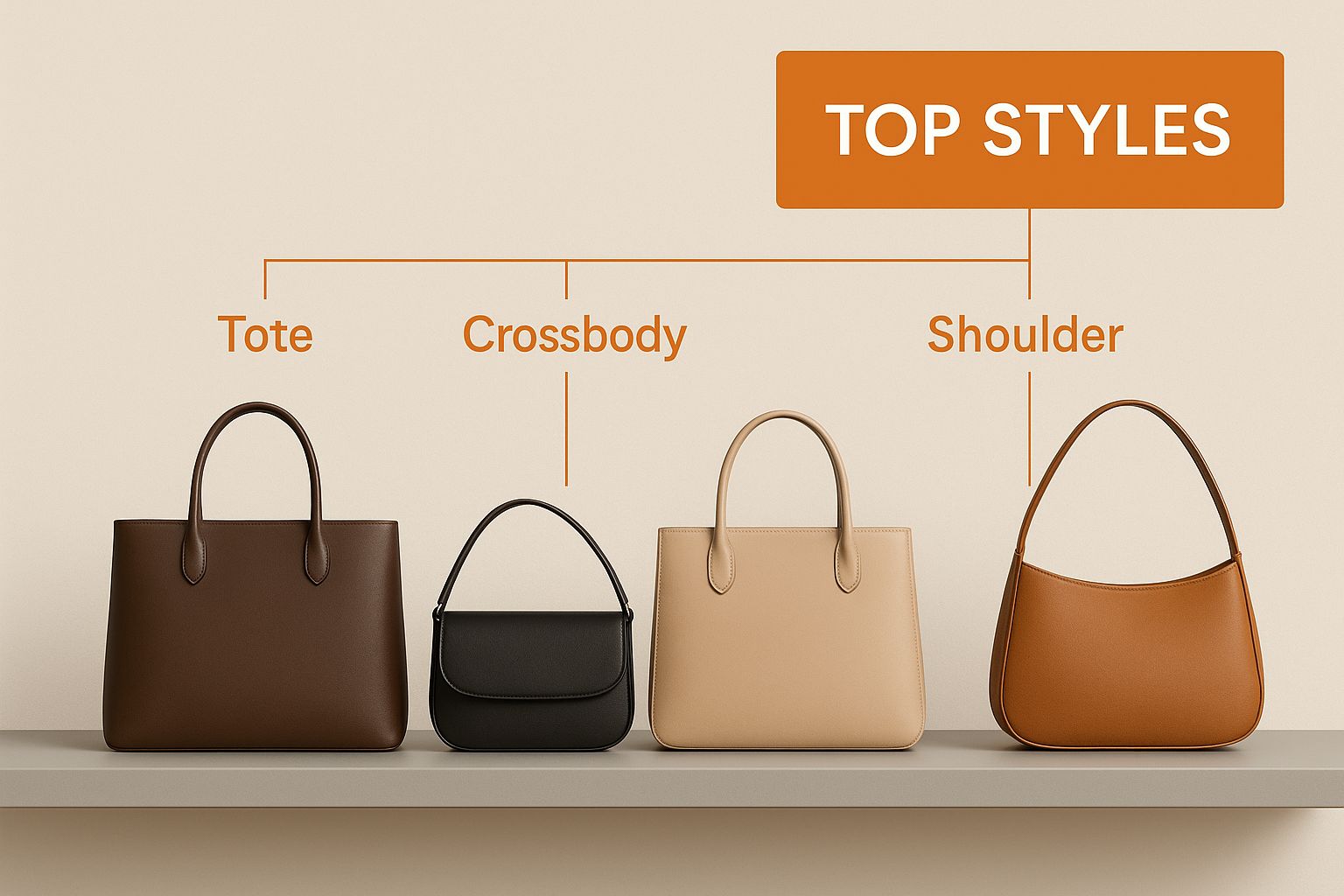
As you can see, classic, minimalist designs are often the perfect canvas to show off the unique, natural character of a high-quality hide.
The Hierarchy of Leather Grades
Not all leather is the same. Far from it. The grade of the leather tells you everything about its strength, durability, and how it will age over the years. Understanding these terms will help you spot true quality and know what you're paying for when looking for the best leather handbags women can buy.
-
Full-Grain Leather: This is the best of the best—the absolute top tier of leather quality. It's made from the outermost layer of the hide, so it keeps all the original, natural grain and markings. Full-grain is incredibly strong and develops a gorgeous patina (that soft, unique sheen that comes with age and use), making it even more beautiful over time.
-
Top-Grain Leather: Coming in a close second, top-grain leather is another fantastic choice. Here, the very top surface has been lightly sanded or buffed to smooth out any imperfections, giving it a more uniform look. It's still a very durable and high-quality option for a handbag that will last, though it won’t develop that same deep, rich patina you get with full-grain.
-
Corrected-Grain & Genuine Leather: Now, these terms can be a bit tricky. "Genuine leather" sounds great, but it really just means the product is made of real leather—often from the lower, less durable layers of the hide. Corrected-grain has been heavily processed with an artificial grain pattern stamped on top. While they're much more affordable, these leathers just don't have the long-lasting character of their higher-quality cousins.
Here's an easy way to think about it: choosing full-grain or top-grain leather is like buying solid wood furniture instead of something with a veneer. One is built to last for generations and tells a story, while the other looks nice for a while but lacks that same depth and longevity.
Understanding Common Leather Finishes
Beyond the grade of the hide, the finish is what gives a handbag its final look and feel. The finish also plays a huge role in how well your bag will stand up to scratches, stains, and the rigors of daily life.
Here are a few of the most popular finishes you'll come across:
- Pebbled Leather: You’ll recognize this one by its bumpy, textured surface. It’s a fantastic choice for an everyday bag because that texture does an amazing job of hiding minor scuffs and scratches.
- Saffiano Leather: Famous for its signature cross-hatch pattern, Saffiano leather is machine-pressed and then sealed with a wax coating. This makes it incredibly durable, easy to clean, and very resistant to scratches.
- Nubuck & Suede: Both are buffed to create a beautifully soft, velvety feel. While they feel incredibly luxurious, they are also more delicate and can easily stain or get damaged by water, so they require a bit more TLC.
To help you sort through these options, we've put together a simple table breaking down the most common leather types.
Comparing Common Handbag Leather Types
This table breaks down the key characteristics of different leather grades to help you choose the best option for your lifestyle and budget.
| Leather Type | Key Characteristic | Best For | Durability |
|---|---|---|---|
| Full-Grain | Most natural appearance, develops a rich patina | Investment pieces, everyday use for those who love character | Highest |
| Top-Grain | Smooth, uniform finish | Everyday bags that need to be durable but look polished | High |
| Saffiano | Cross-hatch texture, very scratch-resistant | Work totes, travel bags, and high-use items | Very High |
| Pebbled | Textured surface that hides wear | Daily carry-alls, bags for busy lifestyles | High |
| Suede/Nubuck | Soft, velvety feel | Occasional use, special event bags | Low (requires care) |
| Genuine | Lower quality, often heavily processed | Budget-friendly fashion items | Moderate |
Choosing the right leather ultimately comes down to matching the material's properties with how you plan to use your bag.
Knowing these little details empowers you to pick a bag that not only looks incredible but is also perfectly suited to your lifestyle. For more inspiration, check out our guide on the top 10 leather handbag brands for style and quality at https://www.thebagicon.com/blogs/news/top-10-best-leather-handbag-brands-for-style-quality.
And don't forget, the market for high-quality alternatives is always growing. You can find amazing craftsmanship in other materials too, like this stylish and practical Vendula New York Large Ziparound Wallet made from vegan leather.
Exploring Timeless Handbag Styles for Every Need
A beautiful leather hide is only half the story. The perfect handbag marries exceptional material with a design that's both functional and timeless. Understanding the classic handbag silhouettes is your first step to finding a style that doesn't just complement your look, but truly fits into your life.
Some designs have been essentials for decades for one simple reason: they just work. This look into the most iconic styles will help you pinpoint which shapes match your personal taste and daily demands. From the do-it-all tote to the hands-free crossbody, each one has its own special purpose.
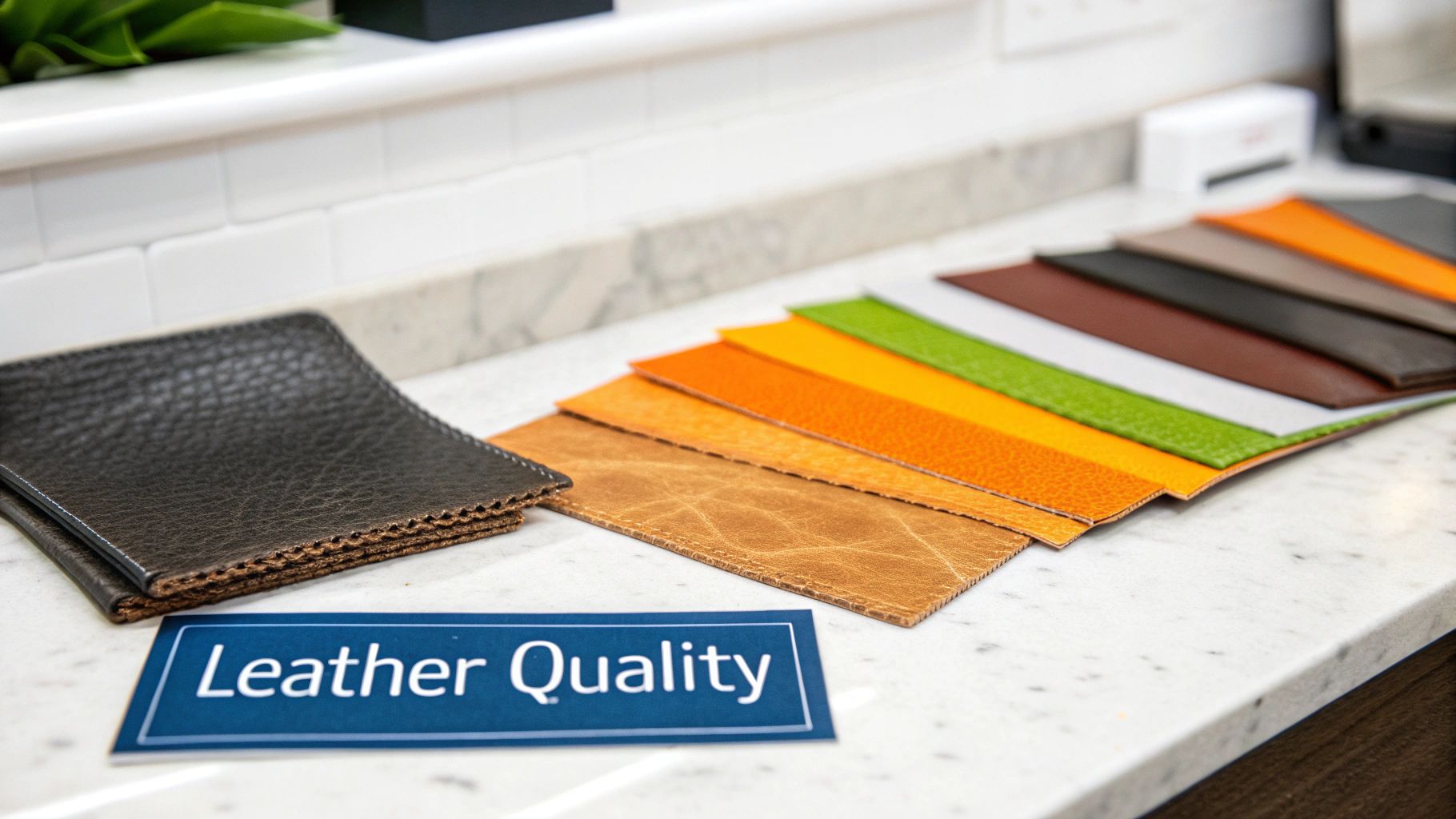
The Unbeatable Tote Bag
Meet the ultimate workhorse of the handbag world. The tote bag, with its large, open-top design and sturdy parallel handles, is built for capacity and pure convenience. This is the bag you grab when your day requires everything from a laptop and work files to a water bottle and an extra pair of shoes.
Its simple, unstructured shape makes it incredibly versatile. A well-made leather tote looks just as at home in a boardroom as it does on a weekend trip to the farmer's market. That's what makes it one of the best leather handbags women can own for all-around utility.
The Structured Satchel
If the tote is about carrying it all, the satchel is about polish and organization. It usually has a flat bottom, a top carry handle, and often a longer strap for shoulder wear, giving it a more structured, rigid shape. This design is great because it stands on its own and keeps its contents protected.
Look inside, and you’ll usually find multiple compartments and pockets, perfect for keeping your essentials neat and easy to find. The satchel strikes that perfect balance between professional elegance and everyday practicality, making it a go-to for anyone who loves an organized bag and a sophisticated look.
A handbag is more than just an item; it's a personal space you carry with you. The right style feels less like an accessory and more like an essential part of your daily routine, perfectly organized for your life.
The Hands-Free Crossbody
For those moments when you need to be quick, agile, and unburdened, the crossbody bag is the clear winner. Worn over the shoulder and across your body, it keeps your hands totally free while making sure your valuables—phone, wallet, keys—are secure and right where you need them.
Its smaller size makes it perfect for so many situations:
- Weekend Errands: Easily navigate busy streets and shops.
- Travel and Sightseeing: Keep your passport and cash safe while you explore.
- Concerts and Events: Enjoy the moment without juggling a clutch.
This style is all about mobility and security, making it an essential piece in any well-rounded handbag collection. When you're looking for an elegant leather handbag as the perfect accessory, understanding what each style offers is key.
Spotting the Key Features of a High-Quality Handbag
Beyond a beautiful leather exterior and a style you love, the real test of a handbag's quality is in its construction. It’s all in the little details—the things you might not notice at first glance—that separate a bag that lasts a season from one you’ll cherish for a decade. Learning to spot these signs of superior craftsmanship is the final step in choosing one of the best leather handbags women can own.
Think of it like buying a well-made coat. You wouldn't just look at the fabric; you'd check the seams, the buttons, and the lining. It’s the exact same principle with a handbag, and once you know what to look for, you'll feel confident assessing any bag that catches your eye.
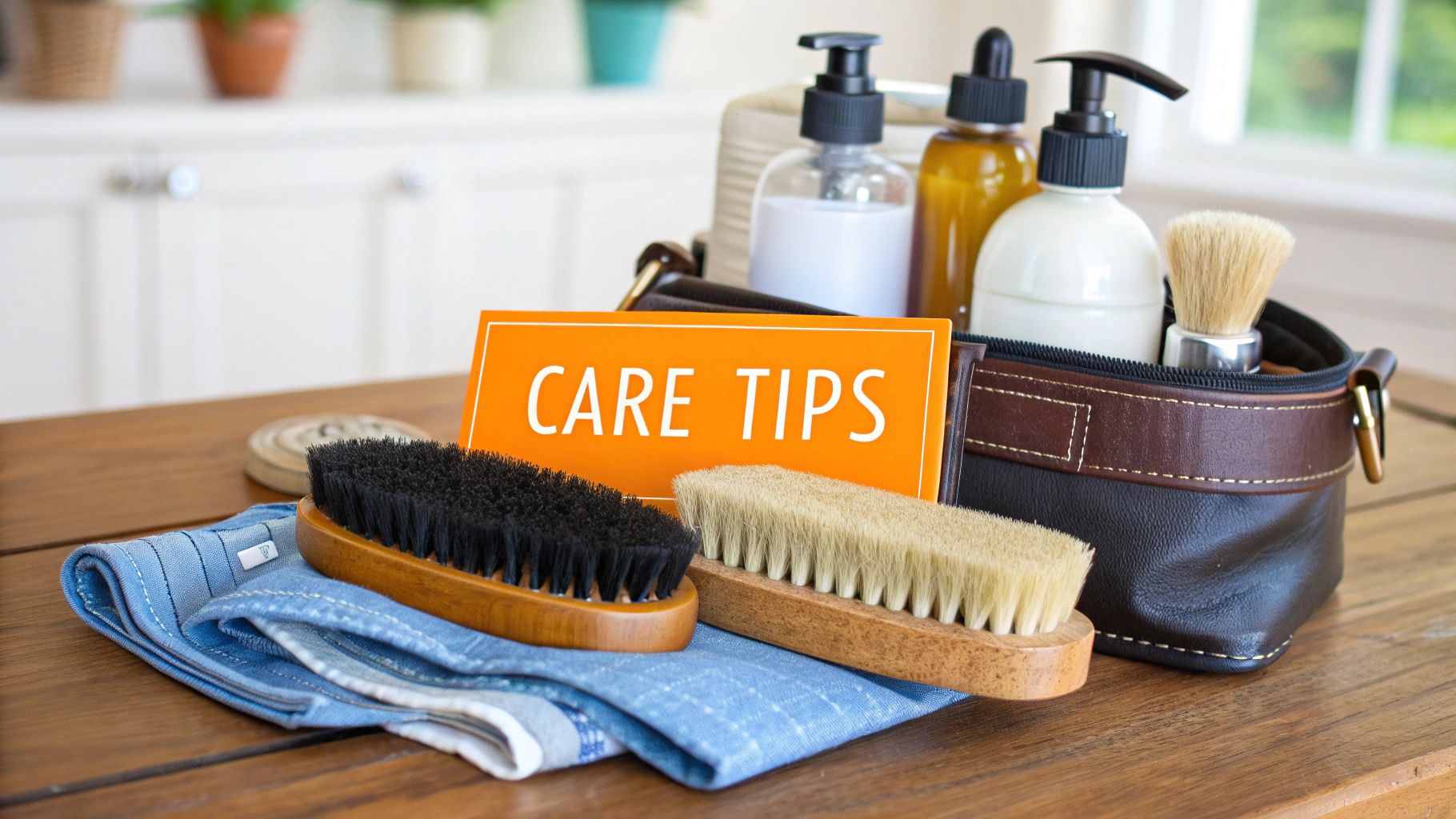
Take a Close Look at the Stitching
The stitching is basically the skeleton of your handbag—it holds every single piece together. On a high-quality bag, the stitches will be small, perfectly uniform, and run in a straight, clean line. You shouldn't see any loose threads, wobbly lines, or uneven spacing.
A higher stitch count (meaning more stitches per inch) creates a much stronger and more durable seam that can easily handle the weight of your essentials and the stress of daily use. Run your fingers along the seams. They should feel totally smooth and secure, with no hint of fraying or weakness.
Feel the Quality of the Hardware
The hardware—zippers, clasps, buckles, and feet—is where many brands try to cut corners. Quality hardware should feel substantial and have some weight to it, not feel flimsy or light. It's typically made from solid metals like brass or nickel that won't easily chip or tarnish over time.
A well-crafted handbag invests in every component. The hardware should operate smoothly and feel solid, as these are the parts that endure constant daily use. A zipper that glides effortlessly is a telltale sign of quality.
Give the zipper a few test pulls. Does it move back and forth smoothly without snagging? Do the clasps open and close with a satisfying, solid click? These small functional tests reveal so much about the overall craftsmanship.
Inspect the Lining and Interior
A bag’s interior is just as important as its exterior. A premium handbag will always feature a durable lining made from materials like canvas, twill, or a high-quality microfiber. These fabrics are tough enough to handle keys, pens, and daily shuffling without tearing or pilling.
Also, check how the lining is sewn into the bag. It should be taut and neat, with no loose, bunchy fabric in the corners. A poorly fitted lining is one of the biggest red flags for a lower-quality bag.
Check for Structural Reinforcements
Finally, look for signs that the bag is built to handle real-life stress. The best leather handbags for women always include smart reinforcements in high-pressure areas to make them last.
Here are the key spots to check:
- Handle Anchors: The points where the handles or straps attach to the bag’s body should be reinforced, either with extra stitching or small metal rivets. This is crucial for preventing the straps from tearing away under weight.
- Reinforced Corners: The bottom corners of a bag see the most wear and tear. Look for extra layers of leather or small metal studs, often called "feet," that protect the base from scuffs and dirt when you set it down.
By paying attention to these crucial construction details, you can be sure your next handbag isn't just stylish, but is truly built to last. This checklist empowers you to make a sound, confident investment.
The Art of Caring for Your Leather Investment
A beautiful leather handbag is so much more than an accessory—it's an investment. And just like any other precious item in your life, it needs a little TLC to keep it looking its best for years to come.
Think of it this way: you wouldn’t leave fine jewelry rattling around in a drawer, would you? The same idea applies here. A bit of routine care ensures your bag not only lasts but also develops that gorgeous, rich patina that only time and love can create. The good news? It's not nearly as complicated as it sounds.
Essential Maintenance Principles
Proper care really boils down to a few simple, consistent habits. These easy steps are the foundation for preserving any of the best leather handbags women choose to bring into their collection.
- Routine Cleaning: Once a week, give your bag a quick wipe-down with a soft, dry microfiber cloth. This little ritual takes seconds but stops dust and daily grime from settling into the leather's delicate pores.
- Conditioning is Key: Think of leather conditioner as moisturizer for your bag. Every few months, applying a quality conditioner replenishes the natural oils in the hide, keeping it supple and preventing it from drying out or cracking.
- Smart Storage: Where you keep your bag matters. When you're not using it, empty it out, stuff it with some acid-free tissue paper to hold its shape, and pop it into its dust bag. Try to avoid hanging it by the straps, as that can cause them to stretch over time.
For a deeper dive, we've put together a complete guide on how to clean your leather purse right here: https://www.thebagicon.com/blogs/news/how-to-clean-leather-purses.
Handling Common Problems
Life happens, and even with the best intentions, scuffs and spills are inevitable. Here’s how to tackle the common culprits.
Quick Tip: Before you try any cleaning product, always test it on a small, hidden spot first—like the inside of a pocket. This simple patch test can save you from a potential color-stripping disaster.
For minor scuffs, you can often gently buff them out with a dab of leather cream or even a clean pencil eraser. If you get caught in an unexpected downpour, blot the water spots right away with a dry cloth and let the bag air dry naturally. Never use a hairdryer or put it near a heater!
This dedication to longevity is a huge part of why European craftsmanship is held in such high regard. The leather handbag market in Europe accounts for a massive 34.33% of the global market share, largely because shoppers there value pieces built to last. You can find more fascinating stats on the global handbag market on fortunebusinessinsights.com. When you invest in quality, it’s worth learning the general principles for maintaining precious investments, whether it's a handbag or a family heirloom.
Common Questions About Leather Handbags Answered
Even after you've learned about all the different leather types and classic styles, there are always a few lingering questions that come up right when you’re about to take the plunge. We get it. Making sense of the world of the best leather handbags women can buy is so much easier when you have clear answers. This section is here to give you straightforward solutions so you can shop with confidence and take care of your new bag like a true pro.
Consider this your quick-reference guide for all those final details. From checking if a bag is the real deal to picking the right color, these insights will make sure you walk away with a purchase you’ll be obsessed with for years.
What Is the Most Durable Type of Leather for a Handbag
If you're looking for pure, unadulterated strength that will last a lifetime, full-grain leather is unmatched. Seriously, it's the best of the best. This grade comes from the very top layer of the hide, which means it keeps all its natural, densely packed fibers intact. That’s what makes it so tough and resistant to daily wear and tear.
Unlike other leathers that get sanded down to look uniform, full-grain leather wears its history with pride, showing off unique, natural marks. Over time, it doesn't just wear out—it gets better. It develops a gorgeous, rich patina that adds a whole new layer of character. A full-grain leather handbag isn't just a purchase; it's a true investment built to handle anything you throw at it.
How Can I Tell if a Handbag Is Made of Real Leather
Spotting real leather from synthetic lookalikes is actually pretty simple once you know the tells. Your own senses are the best tools you have for sniffing out genuine quality.
Here are a few easy tests you can do right in the store:
- Feel the Texture: Real leather isn't perfect; it has a unique grain with slight variations. It should feel supple and a little uneven, while faux leather often feels unnaturally slick and plastic-y.
- Trust Your Nose: You can't fake the smell of genuine leather. It has a distinct, rich, and earthy scent that synthetics just can't imitate. If you get a whiff of chemicals or plastic, that’s a big red flag.
- Press on the Surface: Push your finger into the leather. Real leather will wrinkle and stretch a bit, just like skin does. Faux leather usually just dimples under the pressure before popping right back into place.
- Check the Tag: Always look for labels that are upfront about it. Phrases like "100% genuine leather," "full-grain leather," or "top-grain leather" are what you want to see.
The key thing to remember is that real leather is a natural material. That means it will always have little imperfections and variations. This isn't a flaw—it's the signature of authenticity and quality.
Should I Invest in a Classic Neutral or a Trendy Color
For your first big investment in a beautiful leather handbag, a classic neutral is always the smartest move. Think timeless colors like black, tan, deep brown, navy, or a chic grey. These shades are incredibly versatile and will go with almost everything in your closet, no matter the season. This is how you get the most wear and value out of your bag.
Once you have that reliable, go-to classic in your collection, then you can start having fun with trendier colors and seasonal styles. A good way to think about it is to invest more in a high-quality neutral that will serve you for years, and spend a little less on those fun, statement pieces that add a pop of personality. This balanced approach helps you build a handbag collection that's both functional and fabulous.
How Should I Store My Leather Handbag Properly
Proper storage is a non-negotiable for keeping your bag’s shape, preventing damage, and making sure the leather stays in pristine condition. Just tossing it into the back of your closet is a common mistake that can lead to stretched straps and scuffed corners.
Just follow these simple steps for perfect storage:
- Empty It Completely: Take everything out to keep the lining from stretching and to prevent accidental spills from leaky pens or makeup.
- Stuff It to Maintain Shape: Fill the bag with acid-free tissue paper, a soft cloth, or even an old t-shirt. This helps it hold its structure and prevents ugly creases from forming.
- Use a Dust Bag: Always place your handbag in its original dust bag or a breathable cotton pillowcase. This protects it from light, dust, and moisture.
- Store It Upright: Find a spot for your bag on a shelf in a cool, dry place. Never, ever hang it by the straps, as this will cause them to stretch and weaken over time.
At The Bag Icon, we believe every woman deserves to own a beautiful, high-quality leather handbag without the painful luxury markup. Explore our collection of affordable, elegant designs and find the perfect accessory to elevate your personal style. Discover your next favorite bag today at https://www.thebagicon.com.
